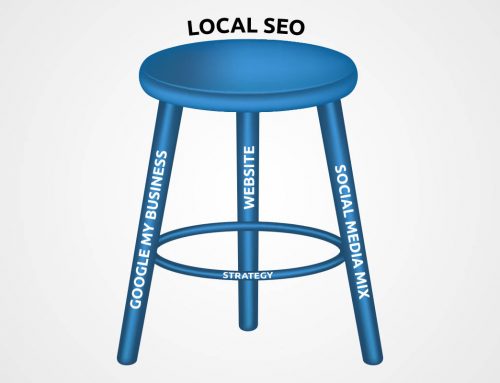Looks Like Grandma Was Right
… when it came to vertical pictures and videos.
Perhaps it was the exodus from the box format of viewing video to the wide screens on TVs and computer/laptop screens that fueled it, or decades of default photography in landscape mode. As smartphones entered the scene in 2009, I recall constantly reminding clients I was working with for online marketing and web design (along with my mom – and just about anyone else in her generation or older) to turn their phones horizontal for pictures and video. Sometimes I felt like Ross from that episode of Friends when they were trying to get a couch up the stairs any time I saw someone starting to take a pic while holding a smartphone upright. Instead of “Pivot…. Pivot… PIVOT!!!”, I would insist “Horizontal!”
Of course, from 2009 to 2013, the majority of internet usage was on desktop or laptop, meaning widescreen viewing was ideal. By 2013, only 16.2% of internet usage was from mobile devices. We’re still waiting for total percentages in 2019, but we know mobile already bested computers and tablets for online activity in 2017 – edging in at just over 50% – and again in 2018 with 52.2%. Naturally, that number is expected to grow again for 2019.
Internet Access via Mobile

What’s Changed?
Basically, a trend became the standard. Something established when you notice the majority of consumer behavior follow a certain pattern. While overall internet usage has just crept over 50% in the last two (now three) years, it’s important to look at stats more specific to how content is being engaged. For example, the majority of social media consumption is on mobile. In fact, most of the access on the internet is app-driven more so than browser-driven. 89% of people on their smartphones are accessing online content from apps, while only 11% are viewing the content from a browser. You’re likely familiar with some of these popular apps. The numbers below are total mobile percentages (app and web):
In the annual report from Depositphotos.com – Visual Trends 2020: Think Ahead, there’s a section committed to directionality of images and video. It basically illustrates that the common sense method grandma has been doing for the last decade – the more natural position of holding the phone – is proving more successful. We can thank SnapChat, FaceTime, Instagram/Facebook Stories, and multiple other apps that started making videos and images in vertical mode significantly more mobile-friendly than ever before.
Some might discard vertical images and videos as a trend, yet billions of images and video that have been shot for the last decade in vertical mode (showing with blurred out video to both sides or negative space on either side for images) are evidence that the average person was naturally defaulting to vertical anyway. Development seems to have finally caught up to users.
Taking Your Business Vertical
The use of vertical video and images isn’t just for grandmas and tweens. Facebook and Instagram are reporting incredible engagement improvements for businesses who’ve returned to the habit of vertical. Here are a few stats:
Like any media platform before, social media isn’t about whether you use it or not, rather how you use it. The fact consumers are responding to and businesses are promoting their businesses on social media isn’t the question. Rather, the question is a matter of how they are engaging. With Instagram, one of the leaders in the Vertical Experience, it may surprise you to know 1/3 of the most viewed stories came from businesses. The reach on Instagram will vary based on location, but the global potential for marketing audience is nearly 820M users.
When you consider the return on investment for marketing and how the shift to vertical can give your business the boost it needs for 2020 and beyond, here are a couple benefits:
- Beside general video consumption abandoning traditional television, 95% of people have their phones in hand while watching shows. During breaks, they ignore commercials being aired (whether on broadcast, cable, or HULU or other streaming services) and check social media, online news, emails, etc. Make the expensive advertising other businesses are engaged in pay off for you by showing up in their social media feeds. If you insist on doing TV commercials, how great would it be to secure brand strength by having your ads potentially show up on their devices while your commercial plays on the TV?
- CPM – Your ability to adapt to how consumers interact has a direct impact on how much your marketing will cost. Vertical image and video ads, with a higher engagement rate, have a lower cost per thousand impressions than other ad forms.

Tips for Vertical Success
Story Time
Knowing where the audience is and how to format the content you put in front of them is only part of the equation. Anymore, a consumer can smell a sales pitch a mile (or a millisecond) away. There is a reason businesses are experiencing success with vertical video and images in Snapchat, Facebook, and Instagram and one word that’s shared across the platforms defines why: Story.
Looking at some of the most successful marketing campaigns ever, stories were at the center. Whether some creative and imaginative story with the product at the center or an illustration of the product in use and benefiting the customer. They’ve far outperformed the feature selling ads. Here are some storytelling ads from recent years that connect with their target audience. They illustrate how the marketing went beyond the what and dug deep into the “WHY” behind consumers choosing their product/services.
“Holiday – The Surprise”
What family hasn’t lived through the siblings “stop touching me” protests from the back seats of a car during vacation travel? What parent or grandparent hasn’t been touched by the precious notes or drawings from children in their family? Apple has both the snowball fight movie shot from an iPhone 11 and this heartwarming story illustrating a modern form a kid’s note/drawing made using an iPad.
“Jacked Up”
One of the most – in my opinion – brilliant ads from State Farm in quite some time. This ad captures how they are equally there for the good and the bad that might be experienced in car ownership. Yet, I can’t share this without giving a significant nod to the Allstate “Mayhem” and State Farm “We’ve know a thing or two, because we’ve seen a thing or two” ad campaigns as they provide a continuous flow of stories lived out by insured drivers in a relatable and comedic illustration.
“The man your man could smell like.”
Knowing that the primary demographic purchasing body wash is women – despite being for men, Old Spice knew they had to connect to the wives/girlfriends out there in a creative way. Short story, it erupted sales for them and became quite the conversation starter and became a viral and interactive marketing campaign.
The parody videos of this ad and other YouTube content generated as a result of this ad are almost endless.
“Promotion”
A two-for-one powerful ad from Indeed. Almost every person who’s ever worked anywhere can relate to the sentiment of being passed up for a promotion. Several use that moment to look elsewhere for work, hoping to be appreciated more elsewhere. Add to that the ongoing dialogue for equality between men and women in the work space, it shouldn’t be lost on anyone the one receiving the promotion is male. This short story tells two stories, even with only one of them being audibly narrated.
“The Gift That Doesn’t Give Back”
I’m not a drinker, but have had those moments in life where I can understand why someone might. This is an example of something argued as being a fail in storytelling and turning it into genius storytelling. Thank, Ryan!
If you haven’t already seen it, here’s the storytelling ad from Peloton that split America when it came to being enraged or engaged: Peloton Wife
My favorite part is the final comment, “You look great, by the way!”
In 2020, look for opportunities to tell stories about your brand you haven’t already shared. Document successes you feel can connect to other potential and even current customers. Look to how what you do is impacting the lives of those who use your company, and build case studies, short posts, and videos describing the benefits experienced. And, for heaven’s sake, “Vertical…. Vertical… VERTICAl!!!” with the pics and videos.






